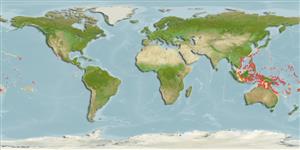Celerina heffernani (Livingstone, 1931)
Heffernani's sea star| Native range | All suitable habitat | Point map | Year 2050 |

|
| This map was computer-generated and has not yet been reviewed. |
| Celerina heffernani AquaMaps Data sources: GBIF OBIS |
Upload your photos
Google image |
No photo available for this species.No drawings available for Ophidiasteridae.
Google image |
No photo available for this species.
Classification / Names Common names | Synonyms | CoL | ITIS | WoRMS
Asteroidea | Valvatida | Ophidiasteridae
Environment: milieu / climate zone / depth range / distribution range Ekologi
Revassocierade; djupintervall 5 - 40 m (Ref. 800). Tropical
Utbredning Länder | FAO områden | Ekosystem | Förekomster | Utplanteringar
Western Central Pacific: Philippines to Solomon Islands and the Great Barrier Reef.
Length at first maturity / Size / Vikt / Age
Maturity: Lm ? range ? - ? cm
Life cycle and mating behavior Könsmognad | Reproduktion | Lek | Ägg | Fecundity | Larver
Members of the class Asteroidea exhibit both asexual (regeneration and clonal) and sexual (gonochoric) means of reproduction. Life cycle: Embryos hatch into planktonic larvae and later metamorphose into pentamorous juveniles which develop into young sea stars with stubby arms.
Main reference
referenser | Koordinator | Medarbetare
Schoppe, S. 2000. (Ref. 800)
IUCN Red List Status (Ref. 130435: Version 2024-1)
CITES status (Ref. 108899)
Not Evaluated
CMS (Ref. 116361)
Not Evaluated
Threat to humans
Harmless
Human uses
| FishSource |
Verktyg
Ytterligare information
Ecology
Population dynamics
Tillväxt
Age/Size
Length-weight
Length-length
Length-frequencies
Mass conversion
Rekrytering
Abundans
Age/Size
Length-weight
Length-length
Length-frequencies
Mass conversion
Rekrytering
Abundans
Life cycle
Distribution
Human Related
Vattenbruksprofil
Stamps, Coins Misc.
Stamps, Coins Misc.
Outreach
Taxonomy
References
Internet-källor
BHL | BOLD Systems | CISTI | DiscoverLife | FAO(Publication : search) | Fishipedia | GenBank (genome, nucleotide) | GloBI | Gomexsi | Google Books | Google Scholar | Google | PubMed | Tree of Life | Wikipedia (Go, sök) | Zoological Record
Estimates based on models
Preferred temperature
(Ref. 115969): 25.3 - 28.9, mean 27.7 (based on 244 cells).
Price category
(Ref. 80766):
Unknown.


